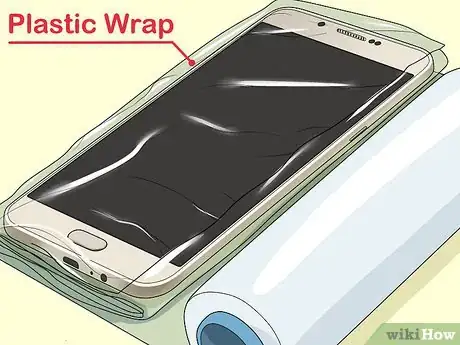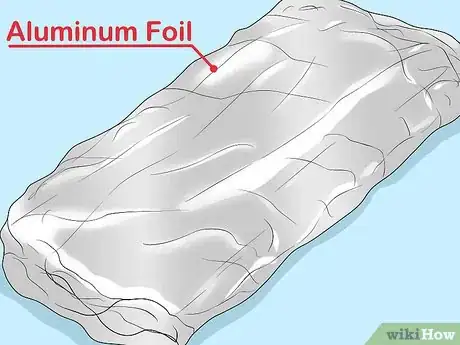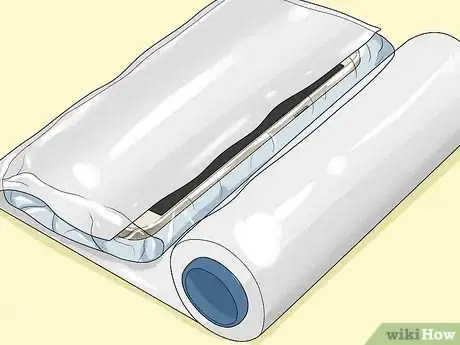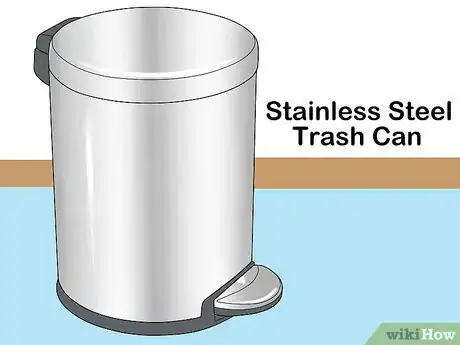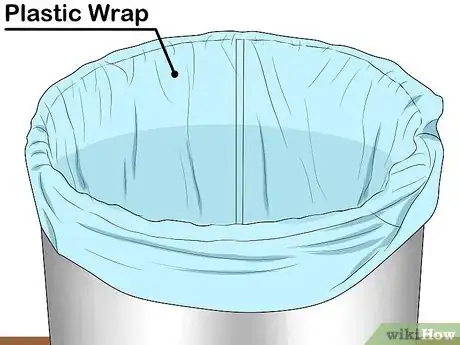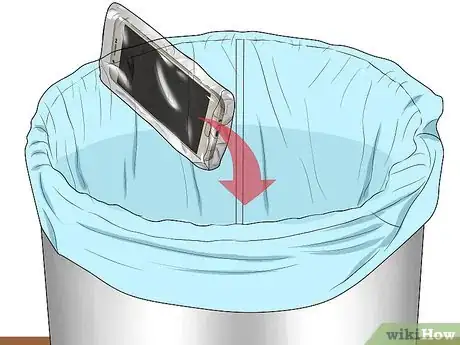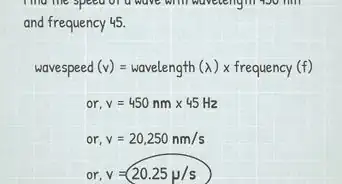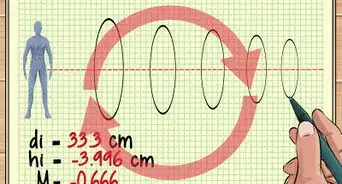This article was co-authored by wikiHow Staff. Our trained team of editors and researchers validate articles for accuracy and comprehensiveness. wikiHow's Content Management Team carefully monitors the work from our editorial staff to ensure that each article is backed by trusted research and meets our high quality standards.
wikiHow marks an article as reader-approved once it receives enough positive feedback. In this case, 92% of readers who voted found the article helpful, earning it our reader-approved status.
This article has been viewed 329,891 times.
Learn more...
The Faraday cage (or shield), named after Michael Faraday, is a device that is used to protect from electromagnetic radiation. A Faraday cage may be formed by a continuous covering of conductive material, or a mesh of such materials. This creates a shielding effect for any item inside the cage and protects those items from radiation. The effects of the cage can be enhanced by layering conductive and non-conductive layers - this creates a cage within a cage within a cage, providing additional protection without the need of specialised materials. Though it may sound complicated, you can make your own Faraday cage from aluminum foil. You can also make a larger version using a steel trash can.
Things You Should Know
- Wrap up your phone, alternating between layers of plastic wrap and tin foil. This helps you create an easy, DIY Faraday cage.
- Find a metal box or container (like a trashcan) and line the inside with plastic wrap. Throw your phone inside and close the lid.
- To create a more sturdy cage, use adhesives or bolts to keep the lid securely closed.
Steps
Making Aluminum Foil Faraday Cages
-
1Wrap your electronic device in a plastic layer. Wrap your device in plastic wrap, or place it in a plastic bag. This will put a barrier between the device and the conductive aluminum layer. It can also serve as a waterproof layer for extra protection.
- You can wrap the item in cloth to help prevent edges from poking holes in the plastic and/or aluminum layers, though this is not necessary.
-
2Cover every inch of the device in aluminum foil. The aluminum foil will act as the conducting layer. There should be no tears or gaps in the foil. Use your hands to mold the foil around the entire device. This is the simplest Faraday cage and should shield your device from low-energy everyday electromagnetic radiations like bluetooth, cellphone signals etc.
- For more protection, you can use more layers of plastic and foil.
- The foil is referred to as a conductive layer. The metal allows radiation to travel along its surface but not through it.[1]
Advertisement -
3Alternate plastic and aluminum foil. You should cover every inch of the device in at least three layers of aluminum. Protection can be maximized by adding plastic layers in between each layer of aluminum foil. This will create alternating layers of conductive and nonconductive materials and shield your device from harmful electromagnetic radiation.
- A Faraday cage is designed to protect devices from an EMP (electromagnetic pulse) blast. This is a high intensity blast of radiation that comes from a weapon or a naturally powerful source (e.g. the sun).[2]
- You can also use a Faraday cage to block a cell phone or radio from getting reception, or prevent your expensive car from being stolen by protecting its (keyless entry) keyfob. In this case, you would need fewer layers since the radiation is much weaker than an EMP blast.
- Adding adhesives like glue between each layer will make your faraday cage more sturdy and permanent, but it will be harder to remove.
Building Larger Faraday Cages
-
1Find a conductive container. A stainless steel trash can with a tight closing lid will work very well. You can look for other metal containers or boxes. This will serve as a first line of defense against electromagnetic radiation.[3]
-
2Line the inside of the container with plastic wrap. Once you have chosen a trash can or another container, line the inside with a layer of plastic wrap. This protects your devices from touching the conductive surfaces of the trash can, and it also provides protection against flooding.[4]
- For added insulation, you can line the inside of the can with cardboard before the plastic layer goes in.
- You can add layers of foil and additional layers of plastic wrap inside to increase the effectiveness of the Faraday cage. More layers will make the cage more effective, even if the layers themselves are thin.
-
3Place your devices inside. Once you have lined your trash can, place your devices inside the can. The best practice is to cover each device individually in its own small Faraday cage (such as the simple aluminum foil Faraday cage). You can also purchase a Faraday bag and place the items in that bag. The trash can will serve as an extra layer of protection.[5]
- Once the devices are inside, you can attach the lid with adhesives or bolt it on for a more sturdy cage. It is also wise to tie the cage down to a beam or bolt it to the wall using a metal strap to make your cage a permanent fixture.
Our Most Loved Articles & Quizzes
Community Q&A
-
QuestionWould copper pots, washtub boilers, etc. make a good Faraday cage?
 Community AnswerSo long as the containers are conductive and can seal properly, those should work pretty well. These would be able to protect small electronics such as cell phones and the like.
Community AnswerSo long as the containers are conductive and can seal properly, those should work pretty well. These would be able to protect small electronics such as cell phones and the like. -
QuestionCan I make a Faraday cage for a car's motor?
 Mick JohnsonCommunity AnswerYou can, but you are then speaking about mothballing a car because all of the sensitive electronic components need protected. You may wish to look at a bicycle motor if you are mechanically inclined, or perhaps an old, old car or surplus jeep: no electronics. A Model T replica, or an actual, maybe a Willy's or something. Heck a golf cart with a lawn mower engine might be what you like best, or you might just be better off with a horse or a good mule because they can thread their way through the throngs of cars that were turned into boulders. Best wishes either way!
Mick JohnsonCommunity AnswerYou can, but you are then speaking about mothballing a car because all of the sensitive electronic components need protected. You may wish to look at a bicycle motor if you are mechanically inclined, or perhaps an old, old car or surplus jeep: no electronics. A Model T replica, or an actual, maybe a Willy's or something. Heck a golf cart with a lawn mower engine might be what you like best, or you might just be better off with a horse or a good mule because they can thread their way through the throngs of cars that were turned into boulders. Best wishes either way! -
QuestionTo make a trashcan Faraday cage, would galvanized cans work the same?
 Community AnswerYes, any conductive metal will work. Silver is the best choice, but very expensive.
Community AnswerYes, any conductive metal will work. Silver is the best choice, but very expensive.
References
- ↑ https://backyardbrains.com/experiments/faraday
- ↑ https://backyardbrains.com/experiments/faraday
- ↑ http://www.survivopedia.com/how-to-build-a-faraday-cage/
- ↑ http://www.survivopedia.com/how-to-build-a-faraday-cage/
- ↑ http://www.survivopedia.com/how-to-build-a-faraday-cage/
- ↑ http://www.pcmag.com/article2/0,2817,2487180,00.asp
About This Article
To make a faraday cage, you'll need to cover your electronic device in alternating layers of materials to create a shield around it that will protect it from radiation. Start by wrapping your electronic device in a layer of plastic wrap. Then, cover every inch of the device in aluminum foil to act as a conductive layer. Add additional layers alternating between plastic and aluminum foil until you’ve formed at least 3 layers of aluminum. Use an adhesive like glue between each layer to make the Faraday cage stronger and permanent. Make sure you cover every inch of the device to shield it from harmful electromagnetic radiation. For tips about how to make a Faraday cage in a conductive container, keep reading!
